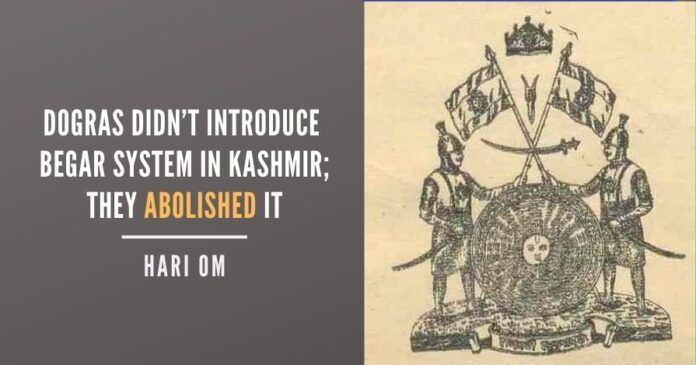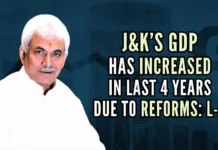
All this should call the bluff of the anti-Dogra elements and establish that the Dogras didn’t introduce the Begar system, but abolished it.
Dogras of Jammu are very unfortunate. They founded the erstwhile State of Jammu & Kashmir in March 1846 and suffered immense socio-economic and political losses after 1947 at the hand of the Kashmiri Muslim ruling elite with New Delhi always at its back and call. They were excluded from the corridors of power for all practical purposes or they were rendered ineffective and unreal. They were denied due to representation in the assembly, council of ministers, secretariat, service sector and financial and professional institutions. Their region, Jammu province, was converted virtually into a Kashmir colony. Jammu’s natural resources were exploited to enrich Kashmir’s economy. So much so, attempts were made to erode the Jammu’s age-old distinct identity by creating the otherwise non-existent Chenab Valley and Pir Panjal Valley out of the mighty Pir Panjal Mountain. The purpose to facilitate the creation of Greater Kashmir.
The Dogras all through accommodated all victims of two-nation doctrine (nearly 20 lakh), but the Kashmiri leaders and the powers-that-be in New Delhi invariably called them communal, reactionaries, backwards-looking and what not. The Pakistani invaders and their cohorts in what we term Pakistan-occupied-Jammu & Kashmir (PoJK) murdered almost 80,000 Hindus and Sikhs in 1947-1948, abducted, converted and auctioned 1000s of Hindu-Sikh women and girls and converted the whole of PoJK. But the anti-Dogra forces accuse day and night the Dogras of killing 84,000 to 10 lakh Muslims in Jammu City alone in 1947. They deliberately suppress the fact that the total population of Jammu City in 1941 was just 58,000, including 13,212 Muslims. Census reports are there but they would not think it prudent to look at them to give a true story of facts.
It was a “sort of employment exchange service provided to the persons registered under this scheme by the government”.
Not content with all these wild and communally motivated allegations against the Dogras of Jammu, they have unleashed a no-holds-barred vilification campaign against them to tarnish their image and tell the international community that the Dogras of Jammu introduced Begar system (forced labour) in Kashmir to persecute Muslims. Not just this, they claim that Begar system was in vogue during the time of Maharaja Hari Singh (1925-1947).
When was Dogra rule established in Kashmir? It was established in March 1846. Did not Begar System exist in Kashmir before 1846? It did exist. It existed during the Sultanate period, including the period of Sultan Zain-ul-Abidin (1420-1470). In fact, it was during his period that Kashmir witnessed a revolt against the Begar System and it was engineered by Chaks of Dardistan (all Shiites). In this regard, Baharistan-i-Shahi said: “The Chaks, apprehensive of the dreadful prospect of being subjected to forced labour, such as the carriage of luggage and the like in the event of the Sultan taking up his residence there, displayed a spirit of revolt”. “When Zain-ul-Abidin went to the new city of Zainagiri and requisitioned the services of people for forced labour, the Chaks were conspicuous by their absence. The Sultan, however, forced them to work. But when he left, Pandu Chak, leader of the Chaks, and his followers set fire to the palace and other government buildings in Kamraj”.
Begar system was prevalent during the Mughal period (1586-1753) also. The inscription on the Kathi Darwaza of Akbar’s Fort around Hari Parbat proves that. Not just this, when in 1665, Mughal ruler Aurangzeb (1656-1707) visited Kashmir, he employed 30,000 porters to carry his imperial camp luggage from Bimber in Jammu (now in PoJK) to Kashmir. Some of the porters were provided by the Governor of Kashmir. The Mughal rule in Kashmir came to an end in 1753. It was replaced by the Afghan rule, which continued till 1819. No Afghan ruler tried to abolish the system. In fact, the system under them assumed the brutal form. In 1819, Kashmir came under the Sikh rule. The Sikh rule lasted till March 1846. The Sikh rulers also did “little or nothing” to abolish the system.
This was the situation in Kashmir before March 1846. Credit goes to Dogra rulers, including the founder of Jammu & Kashmir State, Gulab Singh (1846-1857), Ranbir Singh (1857-1885) and Pratap Singh (1885-1925). Maharaja Gulab Singh was the first ruler who took some concrete steps to improve the system. He couldn’t abolish it due to the pressure of circumstances but he did a make a rule of paying in kind to those engaged for doing the state work, including constriction of roads. In other words, he changed the system of Begar into that of forced paid labour. His son, Ranbir Singh, went a step further. He changed the system of payment in kind to cash. However, it was Maharaja Pratap Singh who abolished the system in 1920. Left to him, Pratap Singh would have abolished it in 1891 itself, but the British Residents posted in the state by the British Indian Government didn’t allow him. Settlement Officer, Walter Lawrence, even went to the extent of saying that it was the “right of the sovereign to take forced labour on payment” as he thought was done in British India. However, that year, a department to regulate the Begar system known as Civil Transport Department was established. The objective was to mitigate the problems, including the problem of suitable residential accommodation, being faced by those engaged by the government to do the state work. In 1917, the Government of Maharaja Pratap Singh took one more important step towards the abolition of the forced paid labour. Rules were framed with regard to the registration of the coolies in the seasonal employ of the visitors and officials for manual work under the new name of “Kashmiri Servants”. They were registered under the two heads, Viz. Permanent Collies, and daily or monthly labourers. The registered persons were issued badges at the government cost. It was a “sort of employment exchange service provided to the persons registered under this scheme by the government”.
The anti-Dogra elements claim that “the Begar system in Jammu and Kashmir during the Dogra rule was imposed exclusively on the Muslim subjects of Kashmir and all Hindus were exempted”. This is a distortion of sorts and the murder of history. The J&K General and Political Department’s files, including File No. Q-27/172 of 1916 (available in the Jammu Archives Repository), clearly says that “Hindus of Jammu were also engaged to perform begar and were not exempted, not even the family members of the sepoys of the Dogra army”.
All this should call the bluff of the anti-Dogra elements and establish that the Dogras didn’t introduce the Begar system, but abolished it.
Note:
1. The views expressed here are those of the author and do not necessarily represent or reflect the views of PGurus.
- ‘Kashmir My core constituency’: Revisiting July 12, 2003 to understand politics, Omar Abdullah-style - March 15, 2024
- Total deviation from traditional approach: Seven takeaways from PM Modi’s March 7 Srinagar visit - March 9, 2024
- Status of political parties: Why is further J&K reorganization imperative? - March 1, 2024










